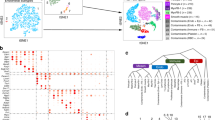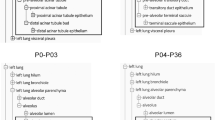Summary
The genomic components identified by each of two closely related cDNA clones for the major 35 kilodalton non-serum surfactant-associated proteins (PSP-A) were shown to derive from human chromosome 10 by Southern blot analysis of DNAs from human-rodent somatic cell hybrids. By in situ hybridization to human metaphase chromosomes, the cDNA probes were localized to the region 10q21-q24.
Similar content being viewed by others
References
Bhattacharyya SN, Passero MA, DiAugustine RP, Lynn WS (1975) Isolation and characterization of two hydroxyproline-containing glycoproteins from normal animal lung lavage and lamellar bodies. J Clin Invest 55:914–920
Brook JD, Shaw DJ, Meredith L, Bruns GAP, Harper PS (1985) Localization of genetic markers and orientation of the linkage group on chromosome 19. Hum Genet 69:282–285
Bruns GAP, Mintz BJ, Leary AC, Regina VM, Gerald PS (1979) Human lysosomal genes: arylsulfatase A and beta-galactosidase. Biochem Genet 17:1031–1059
Bruns G, Kurnit D, Gerhard D, Housman D (1984) cDNA clones on chromosomes 11p and 12p identified with LDH oligonucleotides. Cytogenet Cell Genet 37:428
Donlon TA, Litt M, Newcom SR, Magenis RE (1983) Localization of the restriction fragment length polymorphism D14S1 (pAW-101) to chromosome 14q32.1→32.2 by in situ hybridization. Am J Hum Genet 35:1097–1106
Dryja TP, Bruns GP, Orkin SH, Albert DM, Gerald PS (1983) Isolation of DNA fragments from chromosome 13. Retina 3:121–125
Feinberg AP, Vogelstein B (1983) A technique for radiolabelling DNA restriction endonuclease fragments to high specific activity. Anal Biochem 132:6–13
Floros J, Phelps DS, Taeusch HW (1985) Biosynthesis and in vitro translation of the major surfactant-associated protein from human lung. J Biol Chem 260:495–500
Floros J, Steinbrink R, Jacobs K, Phelps DS, Kriz R, Reeny R, Sultzman L, Jones S, Taeusch HW, Frank HA, Fritsch E (1986) Isolation and characterization of cDNA clones for the 35 kDa pulmonary surfactant-associated protein. J Biol Chem 261:9029–9033
Grzeschik KH, Kazazian HH (1985) Report of the committee on the genetic constitution of chromosomes 10, 11 and 12. Cytogenet Cell Genet 40:179–205
Harper ME, Saunders GF (1981) Localization of single copy DNA sequences on G-banded human chromosomes by in situ hybridization. Chromsoma 83:431–439
Harper ME, Ullrich A, Saunders GF (1981) Localization of the human insulin gene to the distal end of the short arm of chromosome 11. Proc Natl Acad Sci USA 78:4458–4460
Hawgood S, Benson BJ, Hamilton RL (1985) Effects of a surfactant-associated protein and calcium ions on the structure and surface activity of lung surfactant lipids. Biochemistry 24:184–190
Katyal SL, Singh G (1981) Analysis of pulmonary surfactant apoprotein by electrophoresis. Biochim Biophys Acta 670:323–331
King RJ (1982) Pulmonary surfactant. J Appl Physiol Respir Environ Exerc Physiol 53:1–8
King RJ, Klass DJ, Gikas EG, Clements JA (1973) Isolation of apoprotein from canine surface active material. Am J Physiol 224: 778–795
King RJ, Carmichael MC, Horowitz PM (1983) Reassembly of lipid protein complexes of pulmonary surfactant: proposed mechanism of action. J Biol Chem 258:10672–10680
Latt SA, Willard HF, Gerald PS (1976) BrdU-33258 Hoechst analysis of DNa replication in human lymphocytes with superaumcrary or structurally abnormal X chromosomes. Chromosoma 57:135–153
Phelps DS, Taeusch WH, Benson B, Hawgood S (1984) An electrophoretic and immunochemical characterization of human surfactant-associated proteins. Biochim Biophys Acta 791:226–238
Shelley SA, Balis JV, Paciga JE, Knuppell RA, Buffalo EH, Bouis PJ (1982) Surfactant “apoproteins” in human amniotic fluid: an enzyme-linked immunosorbent assay for the prenatal assessment of lung maturity. Am J Obstet Gynecol 144:224–228
Southern EM (1975) Detection of specific sequences among DNA fragments separated by gel electrophoresis. J Mol Biol 98:503–517
Sueishi K, Benson BJ (1981) Isolation of a major apolipoprotein of canine and murine pulmonary surfactant: biochemical and immunochemical characteristics. Biochim Biophys Acta 665:442–453
Yunis JJ (1976) High resolution of human chromosomes. Science 191: 1268–1270
Author information
Authors and Affiliations
Rights and permissions
About this article
Cite this article
Bruns, G., Stroh, H., Veldman, G.M. et al. The 35 kd pulmonary surfactant-associated protein is encoded on chromosome 10. Hum Genet 76, 58–62 (1987). https://doi.org/10.1007/BF00283051
Received:
Revised:
Issue Date:
DOI: https://doi.org/10.1007/BF00283051




